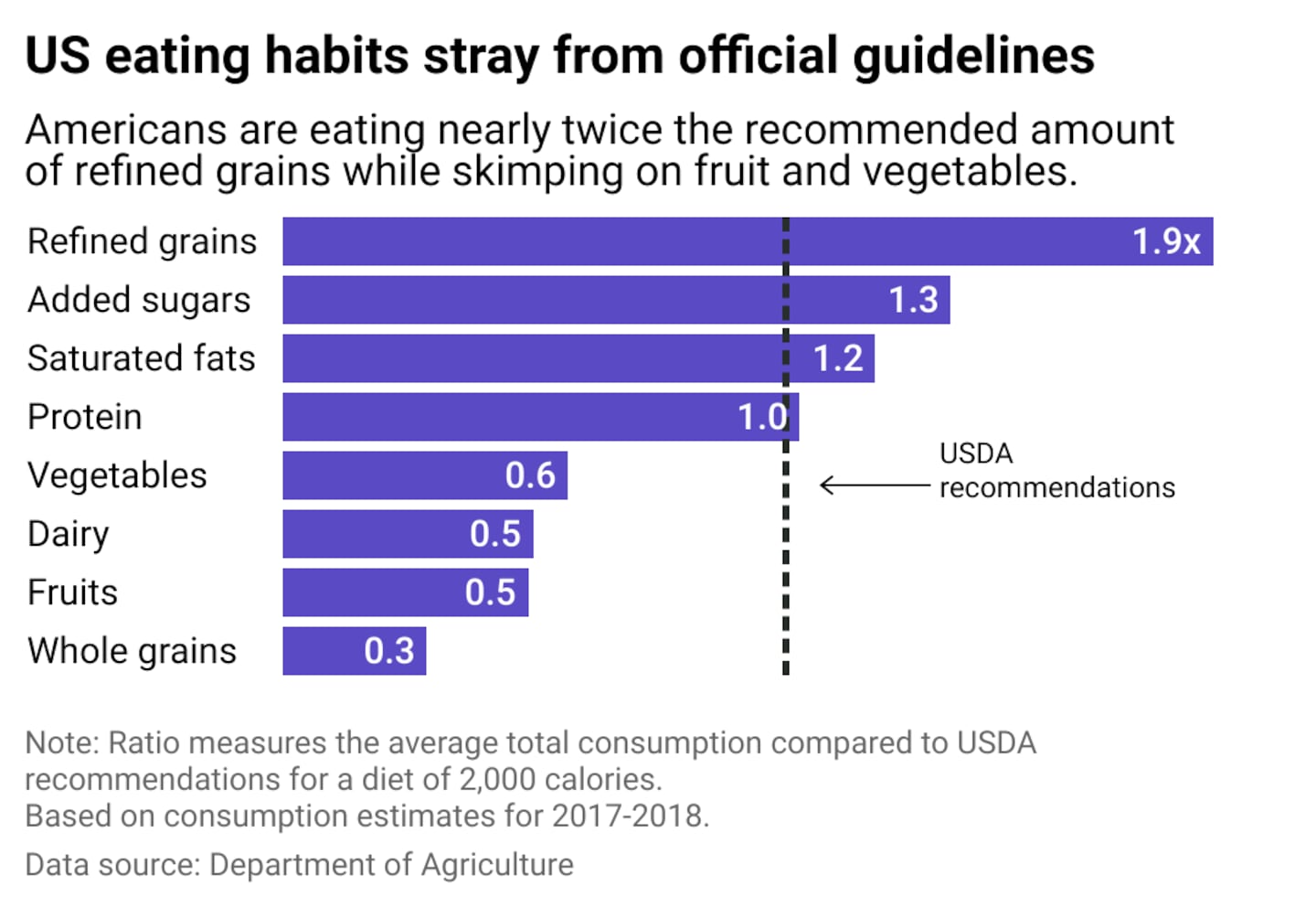Rising inflation at the supermarket has changed the way Americans buy food, altering family menus and daily diets as shoppers stretch their dollars to feed their families. Higher food prices hurt those with lower incomes the most, limiting access to healthy food and impacting long-term health.
In particular, the price of healthy foods has surged. One study from the University of Warwick found that Americans pay 40% more for fruits and vegetables due to enormous fixed costs in supplying them to markets, resulting in less consumption of these healthier foods. A 2022 national survey by the Cleveland Clinic found that the perceived high cost of healthy food was the biggest barrier to a healthier diet, with nearly half (46%) of respondents saying so.
The result is that Americans are compensating by eating too many sugary and ultra-processed foods—which tend to be cheaper and more durable—and not enough fruits, vegetables, and other nutrient-rich whole foods. Despite government programs encouraging and subsidizing healthy foods, the problem is only growing.
"There's evidence that inflation continues to shape food choices, particularly for low-income Americans who prioritize price over healthfulness," Constance Brown-Riggs, a registered nurse and nutritionist specializing in diabetes care, told Stacker.
According to the International Food Information Council's 2024 Food & Health Survey, at least 3 in 4 American consumers cited price as a key driver of food purchases; however, just over half (55%) of low-income households ranked healthfulness as a top factor. In contrast, the healthfulness of food purchases only became more important than the price for those households earning $100,000 or more.
"These results highlight the disparity in how income influences food priorities," Brown-Riggs said, adding that higher food prices often increase food insecurity. "These shifts increase the risk of chronic diseases such as diabetes, heart disease, and obesity."
The United States Department of Agriculture's Healthy Eating Index reflects this need for better-quality American diets. The most recent index found that Americans (above the age of 2) scored an average of 58 out of 100, which is hardly encouraging.
"It has become increasingly clear that diet-related chronic diseases, such as cardiovascular disease, Type 2 diabetes, obesity, liver disease, some types of cancer, and dental caries [cavities], pose a major public health problem for Americans," the 2020-2025 Dietary Guidelines for Americans report found. Adults over 60 did a bit better, averaging a score of 61.
Northwell Health partnered with Stacker to examine how rising prices for healthy foods impact low-income families, using data from the USDA's Healthy Eating Index.
Northwell Health
Americans aren't eating enough whole foods
While several factors contribute to the quality of American diets, rising prices are a meaningful component. With the cost of goods rising across the economy, consumers must make difficult choices regarding necessities like food.
The USDA estimates that 18 million households experienced food insecurity in 2023, an increase of 1 million households since 2022. About 3.2 million families with children under 18 had to reduce or skip their meals altogether. With increasing costs at the cash register, everyday healthy foods may be too expensive for millions of Americans. As a result, many are skimping to fill their shopping carts, but more affordable foods can sometimes come at a higher cost to their long-term health.
When cost is a factor, more people opt for these processed foods, which tend to be cheaper, have longer shelf lives, and produce a short-term feeling of being full due to containing higher carbohydrates, Aimee Aristotelous—nutritionist and bestselling author of nutrition books like "Almost Keto" and "The Whole Food Pregnancy Plan"—told Stacker.
"These items are convenient, calorie-dense, widely accessible, and marketed aggressively," Aristotelous said. Cheap and easily available items like this include breakfast cereals, pasta, deli meats, ultra-processed snack foods, sugary beverages, shelf-stable and frozen meals, and packaged desserts.
"The health implications of these processed foods are dire, as most consist of empty calories that offer little nutrition," Aristotelous added. In other words, she said, the average American diet, when cost-conscious, lacks sufficient whole foods.
Andrey_Popov // Shutterstock
Local and state governments work to improve food access
Government-funded programs such as the Supplemental Nutrition Assistance Program and the Special Supplemental Nutrition Program for Women, Infants, and Children (better known as SNAP and WIC, respectively) are two primary food assistance programs that provide low-income Americans with resources to purchase healthy food. Many use these benefits to buy fruits, vegetables, meat, poultry, fish, dairy products, bread and cereals, eggs, and baby foods and formulas.
Many local programs also try to alleviate some of the burden of high prices at the cash register. For instance, the Local Initiatives Support Corporation invests in food outlets like groceries, food co-ops, and farmers markets in urban and rural communities nationwide to support healthy food distribution. Another example is New York City's Green Carts program, which works to increase access to fresh fruits and vegetables in its neighborhoods.
As much as these advocacy and subsidy programs help, the downward trend in healthy eating is pervasive. Inflation makes shopping for healthy food harder but not impossible. It's about habits as much as price tags.
"An effective way to allocate more money to healthy foods is to eliminate empty-calorie foods and beverages from the grocery list," Aristotelous said. "Soda, packaged desserts, and chips are actually quite expensive in comparison to other nutritious selections."
For example, she said, $5 can buy a six-pack of Coca-Cola or a gallon of milk. It can purchase five pounds of bananas or a large bunch of broccoli, while a bag of chips could be the same price.
"Whole foods that are less expensive than many unhealthy processed foods include sweet potatoes, lettuces, cabbage, carrots, squash, beans, lentils, quinoa, oranges, frozen berries, apples, canned fish, ground beef, and poultry," Aristotelous said. "Not only does it cut significant expenses, but drinking water as one's primary beverage is also the most beneficial beverage option for wellness."
Brown-Riggs offered two main tips for budget-friendly healthy meal planning: Buy in bulk and choose plant-based proteins. Nonperishable items like whole grains, beans, and frozen vegetables can be purchased in large quantities to save money over time. Plant-based protein sources, such as beans and lentils, as well as eggs and canned fish, are also available and are often more affordable than meat.
Beyond the prices on store shelves, healthy eating is a complex issue that requires attention—and not just on an individual level. As the American Heart Association pointed out, structural racism and neighborhood segregation plays a role in what gets on people's plates. These systemic issues have created "food deserts" and environments that often burden Black and Hispanic communities.
The government defines a food desert as an area with a poverty rate of at least 20% and where at least 33% of the population live more than 1 mile (or 10 miles in rural areas) from a grocery store. In these communities, residents often need access to public transit or a car and gas to reach their nearest supermarket. This makes it even more expensive to find healthy foods as transportation is the second-highest household expense behind housing and has also undergone widespread inflationary increases. Research has found that fast-food restaurants and advertising for processed foods and beverages often proliferate in food deserts, making them an unhealthy but far more convenient and affordable choice.
Apart from individual financial support, efforts can also be made to mount larger initiatives, such as installing gardens at schools, incentivizing grocery stores to be set up in underserved neighborhoods, and education programs that inform people about the benefits of healthy eating.
"We need a huge effort from a lot of fronts," prominent nutrition scholar Penny Kris-Etherton told the American Heart Association. "It needs to be across the board from multiple domains, and it really has to be intertwined."
Story editing by Carren Jao and Elisa Huang. Copy editing by Paris Close. Photo selection by Clarese Moller.
This story originally appeared on Northwell Health and was produced and distributed in partnership with Stacker Studio.







